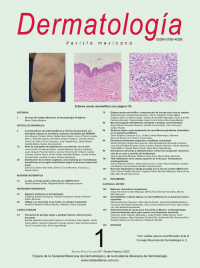Distribution of organic and mucocutaneous myiasis by Cochliomyia hominivorax in maxillofacial region according to the seasonal situation.
Dermatol Rev Mex. 2023; 67 (1): 26-32. https://doi.org/10.24245/dermatolrevmex.v67i1.8549
Samuel E Urbano-Del Valle,1 Eilien G Tovío-Martínez,2 Francisco L Duque-Serna3
1 Odontólogo. Especialista en Estomatología y Cirugía Oral de la Universidad de Cartagena, Colombia. Residente de tercer año de Cirugía Oral y Maxilofacial. Investigador del grupo GITOUC.
2 Odontóloga. Especialista en Estomatología y Cirugía Oral de la Universidad de Cartagena, Colombia. Investigadora del grupo GITOUC.
3 Odontólogo. Especialista en Estomatología, Cirugía Oral y Maxilofacial, Alta Gerencia. Profesor titular, Facultad de Odontología, Universidad de Antioquia. Medellín, Colombia.
Resumen
OBJETIVO: Describir la distribución regional de los casos de miasis en la población atendida en el Servicio de Cirugía Maxilofacial y Estomatología del Hospital San Vicente de Paul en Medellín-Antioquia, Colombia.
MATERIALES Y MÉTODOS: Estudio descriptivo, retrospectivo, en el que se evaluaron las historias clínicas que se realizaron de manera virtual en el servicio de Cirugía Maxilofacial del Hospital San Vicente Fundación, de enero de 2015 a diciembre de 2020, llevando a cabo la búsqueda mediante el filtro de la palabra “miasis”, analizando como variables el sitio anatómico afectado, la edad y el sexo de los pacientes y el mes de la infestación.
RESULTADOS: Se incluyeron 31 pacientes, de éstos 19 eran hombres, con mayor afección en la herida abierta en la región maxilofacial, la cavidad oral y el sitio quirúrgico; todos ellos se diagnosticaron en periodos de mayor humedad y temperatura.
CONCLUSIONES: En la región facial la miasis es una afección que ocurre con baja incidencia, principalmente durante periodos de mayor humedad y temperatura, por lo que se aconseja llevar a cabo las medidas necesarias durante estos periodos con el objetivo de evitar la infestación larvaria.
PALABRAS CLAVE: Miasis; larva; ivermectina; humedad; infecciones oportunistas.
Abstract
OBJECTIVE: To describe the regional distribution of myiasis cases in the population attended at Maxillofacial Surgery of Hospital San Vicente Fundación, Medellín-Antioquia, Colombia.
MATERIALS AND METHODS: A descriptive, retrospective study was done evaluating the clinical records that were carried out in a virtual way of the service of Maxillofacial Surgery of Hospital San Vicente Fundación, from January 2015 to December 2020, carrying out the search using the keyword “myiasis”, analyzing as variables the affected anatomical site, age and gender of patients and month of the infestation.
RESULTS: The total number of patients were 31, of which 19 were men and 12 were women, with greater affection at the level of the oral cavity, open wound in the maxillofacial region and surgical site, all of them being diagnosed in periods of greater humidity and warmth.
CONCLUSIONS: At the facial region, myiasis is a condition that occurs in a low incidence, mainly during periods of greater humidity and warmth, so it is advisable to carry out the necessary measures during these periods with the goal of avoiding larval infestation.
KEYWORDS: Myiasis; Larva; Ivermectin; Humidity; Opportunistic infections.
Recibido: marzo 2022
Aceptado: septiembre 2022
Este artículo debe citarse como: Urbano-Del Valle SE, Tovío-Martínez EG, Duque-Serna FL. Distribución de la miasis orgánica y mucocutánea por Cochliomyia hominivorax en la región maxilofacial según la situación estacional anual. Dermatol Rev Mex 2023; 67 (1): 26-32.

